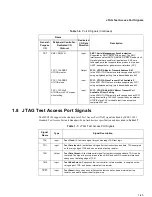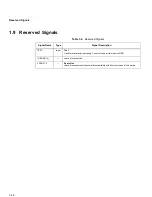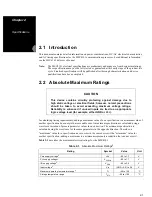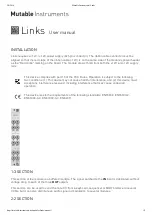
1-33
Communications Processor Module (CPM) Ports
PC29
BRG3O
CLK3
TIN2
SCC1: CTS, CLSN
Output
Input
Input
Input
Baud-Rate Generator 3 Output
The CPM supports up to 8 BRGs. The BRGs can be used
internally by the bank-of-clocks selection logic and/or provide
an output to one of the 8 BRG pins.
Clock 3
The CPM supports up to 10 clock input pins. The clocks are
sent to the bank-of-clocks selection logic, where they can be
routed to the controllers.
Timer Input 2
A timer can have one of the following sources: another timer,
system clock, system clock divided by 16 or a timer input. The
CPM supports up to 4 timer inputs. The timer inputs can be
captured on the rising, falling or both edges.
SCC1: Clear to Send, Collision
Typically used in conjunction with RTS. The MSC8101 SCC1
transmitter sends out a request to send data signal (RTS).
The request is accepted when CTS is returned low. CLSN is
the signal used in Ethernet mode. See also PC15.
PC28
BRG4O
CLK4
TIN1
Timer2: TOUT2
SCC2: CTS, CLSN
Output
Input
Input
Output
Input
Baud-Rate Generator 4 Output
The CPM supports up to 8 BRGs. The BRGs can be used
internally by the bank-of-clocks selection logic and/or provide
an output to one of the 8 BRG pins.
Clock 4
The CPM supports up to 10 clock input pins. The clocks are
sent to the bank-of-clocks selection logic, where they can be
routed to the controllers.
Timer Input 1
A timer can have one of the following sources: another timer,
system clock, system clock divided by 16 or a timer input. The
CPM supports up to 4 timer inputs. The timer inputs can be
captured on the rising, falling or both edges.
Timer 2: Timer Output 2
The timers (Timer[1–4]) can output a signal on a timer output
(TOUT[1–4]) when the reference value is reached. This signal
can be an active-low pulse or a toggle of the current output.
The output can also be connected internally to the input of
another timer, resulting in a 32-bit timer.
SCC2: Clear to Send, Collision
Typically used in conjunction with RTS. The MSC8101 SCC2
transmitter sends out a request to send data signal (RTS).
The request is accepted when CTS is returned low. CLSN is
the signal used in Ethernet mode. See also PC13.
Table 1-5. Port C Signals (Continued)
Name
Dedicated
I/O Data
Direction
Description
General-
Purpose
I/O
Peripheral Controller:
Dedicated I/O
Protocol
















































